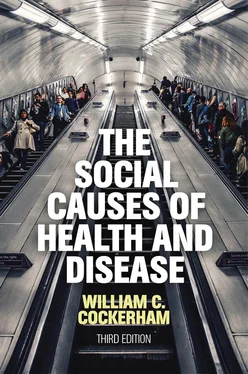The relevance of social factors in causation is also apparent from the different roles these factors perform in the traditional epidemiological agent–host–environment triad. Agents are the immediate or proximal cause of a particular disease and can be biological, nutritional, chemical, physical, or social. Hosts are the people susceptible to the agent, and the environment consists of factors external to the person, including agents, which either cause or influence health. Agents can be social, as seen in the health effects generated by class position, occupations, neighborhoods, and lifestyles; human hosts reflect traits that are both social (habits, customs, norms, and lifestyles) and biological (age, sex, degree of immunity, or other physical attributes that promote resistance or susceptibility); while features of the environment are not only physical but social with respect to poverty and unhealthy living conditions, as well as the social relationships, norms, values, and forms of interaction in a particular social context.
Health-related lifestyles are of particular relevance as a social mechanism producing positive or negative health outcomes. As Anthony Giddens (1991: 81) points out, lifestyles can be defined as a more or less integrated set of practices that fulfill utilitarian needs and give material form to particular narratives or expressions of self-identity, such as class position. Everyone has a lifestyle, including the poor. When it comes to health, lifestyles have multiple roles in that they function as a collective or shared pattern of behavior (agent) that is normative in particular settings (environment) for the individual (host). As will be discussed in chapter 3, health lifestyles can be decisive in determining an individual’s health and longevity as that person moves from childhood into old age (Burdette et al. 2017; Cockerham 2013b; Mollborn and Lawrence 2018). Consequently, health outcomes cannot all be blamed on biology. What is decisive in many cases are social factors, as seen in the further examples of diabetes and HIV/AIDS.
Diabetes is of growing importance in the United States and it is clear that race is a key variable in this development, despite claims that race is simply a social label that by itself should not have any effect on health. What makes race most important with respect to health in American society is its close association with being affluent or poor. Even though members of all races are in each socioeconomic category and many whites are poor, blacks and Hispanics are overrepresented among lower-income groups (Cosby et al. 2019). As for diabetes, both the Type 1 and Type 2 versions are diseases in which excess amounts of sugar (glucose) in the blood damage the body’s organs – promoting kidney failure, heart disease, stroke, blindness, amputations of limbs, and other problems. Type 1 typically appears in childhood when the pancreas quits producing insulin that controls blood sugar levels because the body’s immune system has destroyed the cells that make it. Type 2 or adult onset diabetes is the most common form of the disease and usually develops in people after the age of 40. Some 90 percent of all diabetics are Type 2. This type features the ability to make insulin but the inability of the cells to use it to control blood sugar levels. Type 2 diabetes is often controlled through diet and exercise, but if this fails then oral medications and/or insulin injections are required.
Centers for Disease Control and Prevention (CDC) figures for 2017 indicate that 30.3 million Americans nationwide had diabetes and 84.1 million more were in a prediabetic stage (CDC 2017). One in three children could expect to become diabetic; for Hispanics, it may be as high as one in every two children – thereby suggesting a future explosion in the numbers of diabetics in the United States.
Genetics plays a critical role in that diabetes is more prevalent in certain families and groups than others. A variant gene (TCF7L2) has been discovered that increases the risk of Type 2 diabetes and is carried by more than a third of the American population (Grant et al. 2005). Since people carry two copies of each gene, one inherited from each parent, the extent of the risk depends on whether one or two copies of it have been inherited. The estimated 38 percent of Americans with only one copy are 45 percent more likely than the unaffected population to come down with the disease, while the 7 percent who have inherited two copies are 141 percent more likely than those without the gene to develop diabetes. This gene has existed in the American gene pool for generations and its presence in the body does not guarantee its activation; rather, it enhances the risk. However, the rapid acceleration of new cases in recent years cannot be explained by genetics alone since the human gene pool does not change that fast.
Instead, the culprit appears to be social behavior and is inextricably linked to socioeconomic status and race. Low SES is significant because of what the combination of low income, education, and occupational status signify with respect to the greater likelihood of smoking, obesity, sugar and high-fat diets, and lack of exercise – all pointing toward a greater prevalence of unhealthy lifestyles more common in this population group. Race is important because blacks and Hispanics are twice as likely as whites to become diabetic. The overall prevalence of diabetes, according to the Centers for Disease Control and Prevention (2017), is higher among American Indians/ Alaska Natives (15.1 percent), non-Hispanic blacks (12.7 percent), and Hispanics (12.1 percent) than among Asians (8.0 percent) and non-Hispanic whites (7.4 percent). The relationship between SES and race with respect to diabetes is documented in research by Mario Sims and his colleagues (2011), who found diabetes among African Americans to be patterned along socioeconomic lines. Lower SES blacks had both a significantly higher prevalence and greater incidence of new cases of diabetes than blacks higher up the social scale. The lower the SES, the greater the diabetes; the higher the SES, the less the diabetes.
HIV/AIDS is another example of how race (and class) serves as a social determinant of health in the United States. In the beginning (the mid-1980s), HIV/AIDS was a disease most characteristic of white homosexual males. But gay men, many of whom are affluent and well-educated, were the first to change their social behavior by adopting safe sex techniques in large numbers and the pattern of the disease changed dramatically. By the 1990s, the magnitude of the epidemic – even though it began to decline after 1995 – had shifted especially to non-Hispanic blacks but also to Hispanics. In 2016, the most recent year data were available as this book goes to press, African Americans accounted for 41.1 percent of all HIV diagnoses and Hispanics for 16.1 percent, followed by 12.6 percent for multiracial persons, 9.9 percent for Native Hawaiians and Pacific Islanders, 8.8 percent for American Indians and Native Alaskans, and 5.1 percent for both Asians and whites. Some 81 percent were male and 70 percent gay or bisexual. Most women contract HIV through sexual intercourse with infected men.
There are no known biological reasons why the shift from a predominately white infected population to one that is largely black and other racial minorities took place or why racial factors should enhance the risk of HIV/AIDS. Simply being poor and living in economically disadvantaged areas is not the entire answer as many Hispanics and whites are poor but have lower rates. In addition to poverty, joblessness, minimal access to quality medical care, and a reluctance to seek treatment because of stigma, social segregation is also a factor. Edward Laumann and Yoosik Youm (2001) concluded years ago that blacks have the highest rates of sexually-transmitted diseases because of the “intra-racial network effect.” They point out that blacks are more segregated than other racial groups in American society and the high number of sexual contacts between an infected black core and a periphery of yet uninfected black sexual partners act to contain the infection within the black population. Laumann and Youm determined that even though a peripheral (uninfected) black has only one sexual partner, the probability that partner is from the core (infected) group is five times higher than it is for peripheral whites and four times higher than for peripheral Hispanics. In this instance, the core is the agent, the periphery the host, and the intra-racial network the environment.
Читать дальше












